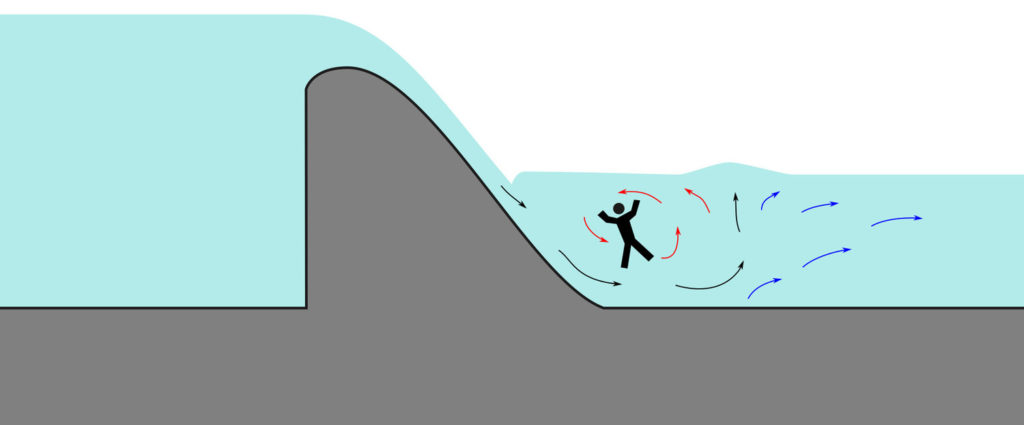
Two men were killed and probably from a low dam no longer kept up. But the dam remains. Should they be removed or do they do something else to protect the river?
For nine days, Kimberly Williams stood watch over the churning and unforgiving waters that had swallowed her husband, waiting for his body to turn up. On Nov. 29, Eric “Josh” Williams had set out from the Poole’s Bluff launch in Bogalusa with his boss Joe Newby. The pair wanted to take Newby’s new mud boat for a spin on the Pearl River. But the pleasure ride soon turned tragic. Hours later, Newby’s body was located. It took more than a week for a state Department of Wildlife and Fisheries team to find Williams, who turned up on a bank in the Red Bluff region of the Pearl River, more than a mile downriver from where the boat launched. “I’m devastated that he’s gone,” Kimberly Williams said, gesturingan underwater structure in the distance. “That’s why I think it’s important that I scream from the top of my lungs that that needs to go away.”
nola.com
Low dams are killing machines and we lose people every year to them.
It’s unclear what exactly happened to the men. But officials said it likely had something to do with the “sill” at Poole’s Bluff. Sills, also known as a low-head dams or a weirs, are underwater concrete walls that maintain water levels upstream but create a dangerous undercurrent behind the wall, earning them the nickname “drowning machine.” The three sills along the Pearl River were completed in 1956 by the Army Corps of Engineers as part of the West Pearl River Navigation Project, designed to maintain water levels in the canal when it was used heavily for commercial navigation. But the canal hasn’t been used for commercial endeavors for decades. As a result, Congress placed the sills — one south of Bogalusa on the Pearl River, one near the meeting of the Bogue Chitto River and the canal and one near the meeting of the canal and the West Pearl River — in caretaker status in 1995 and deauthorized the project in 2016. The area is now primarily used by recreational boaters and swimmers. And because it has been deauthorized, no funding has been dedicated to maintain or improve the structures. According to the National Weather Service, low-head dams have contributed to 111 deaths between 2018 and 2020 across the country. In St. Tammany, at least five people have died and two others have been rescued by the Sheriff’s Office since 2016, said Lance Vitter, a spokesman for the department.
It might make a difference if you grow up with them but accidents can happen even to experienced boaters.
Williams said she met her husband through mutual friends and that he was “her person.” The couple moved to Louisiana from southern Illinois in 2016 and recently bought a house in Holden on the Tickfaw River. “As soon as we got here his face got brighter, his smile was bigger and his eyes were smiling,” she said. “I know that he died a happy man. I just have to go on now without him.” Williams worked at Newby’s HVAC company, which he founded in 2017. Rogers Serpas, a close friend and neighbor, said Newby spent long hours at work but was always quick to help his friends. After Hurricane Ida, he helped cut down trees. Newby also loved hunting, fishing and spending time outdoors. Serpas and Newby had planned to use the boat Dec. 2 to go duck hunting, but Newby wanted to test it on the water first. “He loved the outdoors and we spent many mornings running to a fishing hole, fishing for specks and reds,” Serpas said. “He went down in a duck boat doing what he loved.”
These were not the first deaths nor will they be the last.
Serpas said the sills need to be taken out entirely. “It’s antiquated, it don’t work and it’s killing people on a yearly basis,” he said. “I can’t let Joe’s death go down in vain. It don’t bring him back but even if it saves just one life.” In 2015, Terry O’Keefe Jr. and Jonie Morgan, both of Folsom, were killed while boating with Morgan’s three children on the Pearl River. Officials believe the boat capsized near Lock 3. A teenager on a boat nearby rescued the children and tried to save their mother, but she went under and never resurfaced. Her body was found four days later. Just last year, Michael Golden, a 29-year-old Covington man, fell in at the sill near Lock 3 and died, according to the St. Tammany Parish Sheriff’s Office.
Low dams, as the name says, are low on he water and can be hidden from sight as you come down river.
Sills can be difficult to see from upriver. In a split second, a boat can go from coasting to heading down a waterfall-like jump and into turbulent water with little warning. The water down the jump creates a circulatory hydraulic effect that can trap swimmers and boats beneath the surface. For boaters who set off from the Poole’s Bluff launch, the sill lies around a curve in the waterway. With little visible signage warning of its existence, it can catch boaters unaware until they hit the drop. And when the water on both sides of the sill are about even, it can be difficult to see. Over the years, advocates have tried to remove the sills but have made little progress. They prevent erosion and control sediment and if they were removed “erosion would occur both upstream and downstream of the site,” a corps spokesperson said in an email. If the sills were removed, the pool above Lock 3 would be also be lost, the email said. Mark Schexnayder, a former Louisiana Department of Wildlife and Fisheries official who has spent years working with officials on the issue, said they should be fully removed. Though removing the sills risks changing water levels and drying up the canals off the Pearl River, Schexnayder said that could be remedied, perhaps by damming off the navigation canal and creating more boat launches. For her part, Williams said she’s contacted local, state and federal officials in the hopes that something can be done to prevent future accidents. “Even if it saves just one life it’ll be worth it,” she said.



